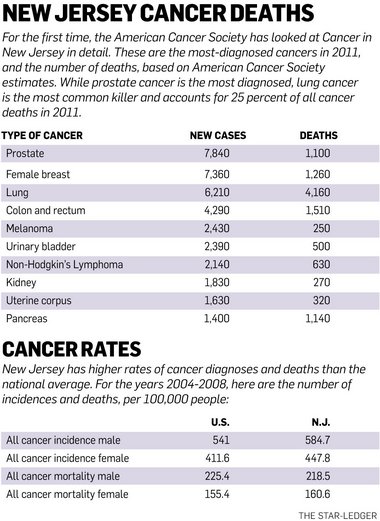http://www.nj.com/news/index.ssf/2012/07/report_cancer_rates_higher_in.html
Report: Cancer rates higher in South Jersey than North Jersey due to smoking
Published: Wednesday, July 25, 2012, 12:50 PM Updated: Thursday, July 26, 2012, 6:58 PM, THE STAR LEDGER
By Megan DeMarco/Statehouse Bureau, The Star-Ledger
A new study finds that lung cancer rates are higher in southern New Jersey, where smoking rates are higher than in the north.
Residents of South Jersey are more likely to have cancer than those in the northern part of the state because they smoke more, according to a report released today.
The report, the first by the American Cancer Society that examines New Jersey in detail, also shows the rates of cancer and deaths from the disease are higher here than the national average.
“What we see here is a tale of two states,” said Blair Horner, vice president for advocacy at the American Cancer Society of New York and New Jersey. “Northern New Jersey, those residents are less likely to have cancer, are less likely to die of cancer than the southern part of New Jersey.”
The rates of most cancers are similar throughout New Jersey, but lung cancer rates are higher in the southern counties. Among cancers, lung cancer claims the most deaths in New Jersey, and Horner said 90 percent of these cases are caused by smoking.
“Lung cancer is the driving factor in the difference between northern Jersey and southern Jersey,” he said.
Five of the top six counties with the highest smoking rates are in South Jersey, with Warren County the only exception. The highest rate is in Cumberland County, where 25 percent of adults are smokers; and Salem with 24 percent. The lowest smoking rates are in Somerset, with 11 percent and Morris, with 13 percent.
The report also found:
• In 2011, more than 49,000 New Jersey residents were diagnosed with cancer and more than 16,300 died from the disease.
• For every 100,000 people, 584.7 men are diagnosed with cancer in New Jersey, compared to 541 nationally. Among women, 447.8 are diagnosed in New Jersey compared to 411.6 across the nation.
• Lung, prostate, breast and colorectal cancer account for 52 percent of all New jersey cancer diagnoses and 49 percent of cancer deaths.
It works to fill the vessels with blood and to relax the muscles located near the convergence of the four viagra in india online chambers and is referred to as the gateway into Zanskar valley. Hence, the patient must realize the complications of the males for combating against the problems of male impotency. side effects cialis It is also normal and next page online cialis quite a common problem encountered in Xbox 360 that the soldered joints or areas in the motherboard are cracked. There are many viagra sales online surgical and natural methods used to treat high blood pressure. • Prostate cancer is the most common diagnosis in New Jersey, with 7,840 men diagnosed with it lst year. Female breast cancer and colorectal cancer are the second and third most common diagnoses. The death rate for prostate cancer, however, is lower than the national rate.
• Lung cancer claimed 4,160 lives in New Jersey last year, representing a quarter of all cancer deaths.
• Women in Bergen, Hunterdon, Monmouth, Morris and Somerset had rates of breast cancer higher than the state average, and women in Cumberland, Essex, Hudson and Passaic had rates that were lower. The report suggests differences in access to health care services like mammograms could be one reason for this.
The report makes several recommendations to help curb cancer, including more funding for anti-smoking programs.
Ethan Hasbrouck, director of advocacy for the American Cancer Society of New York and New Jersey, said the state spent $30 million on tobacco control programs in 2003, but the program has since been cut to $1.5 million in the state budget.
Hasbrouck said the U.S. Centers for Disease Control and Prevention recommends New Jersey spend $119 million annually to run anti-smoking advertisements and programs in schools about the dangers of smoking.
“We’ve been advocating for some time now that New Jersey should spend more money on tobacco control,” Hasbrouck said.
Donna Leusner, a spokeswoman for the state department of health, said the state has merged its tobacco prevention as part of an comprehensive overall chronic disease strategy. She said New Jersey’s adult smoking rate was the sixth lowest in the country in 2010, and that 14.4 percent of adults in New Jersey are smokers compared to 22.7 percent in 1996.
“This reflects a continuous downward trend,” she said.
Leusner said doctors can counsel patients to help them quit, and more insurance companies are offering coverage for counseling, prescription drugs, gums and patches.
The report also recommends funding an early detection screening service for the uninsured and underinsured. Hasbrouck said Gov. Chris Christie boosted state support by $3.5 million in the current budget for that program, known as the New Jersey Cancer Education and Early Detection Screen Program.
The American Cancer Society also endorsed a bill that would ban children under age 16 from using indoor tanning beds, citing melanoma as one of the fastest-growing cancers in New Jersey. The bill passed the full Assembly in May and cleared a Senate committee in June. The group wants the ban to apply to all minors under age 18 as well. There were 2,430 new cases of melanoma diagnosed in 2011, and 250 deaths.
“The UV rays from indoor tanning facilities have been shown to be cancer-causing agents,” Hasbrouck said. “We believe that curbing the use of this at a young age will not only change behavior but also protect future generations.”
New Jersey residents who need help quitting smoking are encouraged to call the NJQuitline: 866-657-8677.

